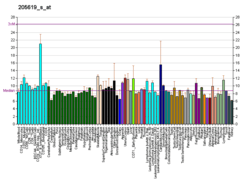MEOX1
Homeobox protein MOX-1 is a protein that in humans is encoded by the MEOX1 gene.[5][6]
Function
This gene encodes a member of a subfamily of non-clustered, diverged, antennapedia-like homeobox-containing genes. The encoded protein may play a role in the molecular signaling network regulating somite development. Alternatively spliced transcript variants encoding different isoforms have been described.[6]
References
- GRCh38: Ensembl release 89: ENSG00000005102 - Ensembl, May 2017
- GRCm38: Ensembl release 89: ENSMUSG00000001493 - Ensembl, May 2017
- "Human PubMed Reference:". National Center for Biotechnology Information, U.S. National Library of Medicine.
- "Mouse PubMed Reference:". National Center for Biotechnology Information, U.S. National Library of Medicine.
- Futreal PA, Cochran C, Rosenthal J, Miki Y, Swenson J, Hobbs M, Bennett LM, Haugen-Strano A, Marks J, Barrett JC (Jan 1995). "Isolation of a diverged homeobox gene, MOX1, from the BRCA1 region on 17q21 by solution hybrid capture". Hum Mol Genet. 3 (8): 1359–64. doi:10.1093/hmg/3.8.1359. PMID 7987315.
- "Entrez Gene: MEOX1 mesenchyme homeobox 1".
- Stamataki D, Kastrinaki M, Mankoo BS, Pachnis V, Karagogeos D (Jun 2001). "Homeodomain proteins Mox1 and Mox2 associate with Pax1 and Pax3 transcription factors". FEBS Lett. 499 (3): 274–8. doi:10.1016/S0014-5793(01)02556-X. PMID 11423130.
Further reading
- Jones KA, Black DM, Brown MA, Griffiths BL, Nicolai HM, Chambers JA, Bonjardim M, Xu CF, Boyd M, McFarlane R (1995). "The detailed characterisation of a 400 kb cosmid walk in the BRCA1 region: identification and localisation of 10 genes including a dual-specificity phosphatase". Hum. Mol. Genet. 3 (11): 1927–34. doi:10.1093/hmg/3.11.1927. PMID 7874108.
- Stelnicki EJ, Kömüves LG, Holmes D, Clavin W, Harrison MR, Adzick NS, Largman C (1997). "The human homeobox genes MSX-1, MSX-2, and MOX-1 are differentially expressed in the dermis and epidermis in fetal and adult skin". Differentiation. 62 (1): 33–41. doi:10.1046/j.1432-0436.1997.6210033.x. PMID 9373945.
- Stamataki D, Kastrinaki M, Mankoo BS, Pachnis V, Karagogeos D (2001). "Homeodomain proteins Mox1 and Mox2 associate with Pax1 and Pax3 transcription factors". FEBS Lett. 499 (3): 274–8. doi:10.1016/S0014-5793(01)02556-X. PMID 11423130.
- Petropoulos H, Gianakopoulos PJ, Ridgeway AG, Skerjanc IS (2004). "Disruption of Meox or Gli activity ablates skeletal myogenesis in P19 cells". J. Biol. Chem. 279 (23): 23874–81. doi:10.1074/jbc.M312612200. PMID 15039437.
- Gianakopoulos PJ, Skerjanc IS (2005). "Hedgehog signaling induces cardiomyogenesis in P19 cells". J. Biol. Chem. 280 (22): 21022–8. doi:10.1074/jbc.M502977200. PMID 15793308.
- Wissmüller S, Kosian T, Wolf M, Finzsch M, Wegner M (2006). "The high-mobility-group domain of Sox proteins interacts with DNA-binding domains of many transcription factors". Nucleic Acids Res. 34 (6): 1735–44. doi:10.1093/nar/gkl105. PMC 1421504. PMID 16582099.
This article is issued from Wikipedia. The text is licensed under Creative Commons - Attribution - Sharealike. Additional terms may apply for the media files.




